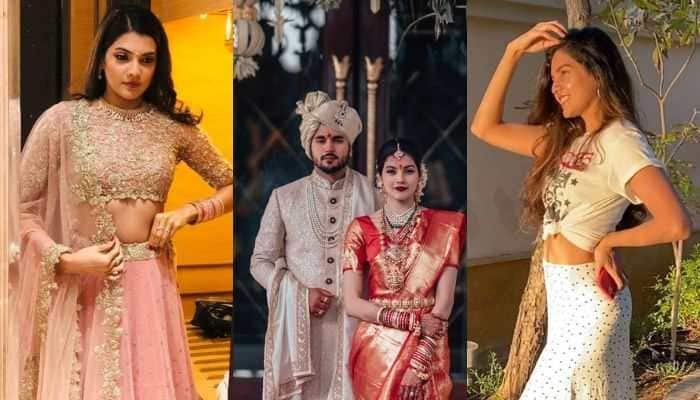Fasting for husband`s well-being
Karva Chauth also known as `Karaka Chaturthi` is a Hindu festival celebrated in Northern Indian states of Punjab, Rajasthan, Uttar Pradesh and Gujarat specially. This day falls nine days before the festival of Diwali or on the fourth day of the dark moon.
Trending Photos
)
Karva Chauth also known as `Karaka Chaturthi` is a Hindu festival celebrated in Northern Indian states of Punjab, Rajasthan, Uttar Pradesh and Gujarat specially. This day falls nine days before the festival of Diwali or on the fourth day of the dark moon. On this day married women keep fast for the complete day for the well being and long life of their husbands who becomes her protector after she leaves her parents home. They don`t even drink water all through the day. The only time they eat or drink is before dawn, and then after the moonrise.
Mother-in-laws, on this day, gift various types of sweets, and dresses to their daughter-in-laws that is called `sargi` in Punjabi. Early in the morning, before sunrise, the married women take bath, get ready and gather to eat an early meal, typically consisting of sweets.
In the afternoon, mothers of newly wed girls give `Baya` to the parents of their son-in-law. Baya, consists of snacks, dry fruits, and some gift items decoratively placed on a plate. In every neighbourhood, the married women gather together in small or large groups to perform puja and to recite the story of Karva Chauth, this is considered a very important part of the day proceedings.
Most women are dressed in beautiful red or pink saris and in traditional gold and silver jewellery. A small area is prepared for the ceremony that can be performed in any part of the house as well as in the open. A small square platform is placed against the wall and kharia matti (powdery mud) is used to cleanse, make anew and decorate the puja area.
An idol of Gaur Mata or Goddess Parvati, the consort of Shiva (the Destroyer in the Hindu Holy Trinity of Creator-Preserver-Destroyer) is placed on the consecrated spot. Traditionally, the tiny image of Gaur Mata was made from cow dung, though nowadays pictures or idols of Parvati are the norm. Married women sit around an idol or painting of Parvati and worship for the well being and long life of their husbands. A small pitcher called Karva with some water is placed in the centre. While the story is being narrated, ladies circulate their Bayas around the circle. After the puja, each one collects her Baya back and gives it to the eldest woman member of the family who blesses the woman with all the happiness in life.
After the story is read out to everyone, the women exchange their respective karvas till each one gets her own karva back, while chanting the following: Addey-addey Krishna pakshe var
Tith Karva Chauth
Manse hain apne suhag ke liye
Yeh karva, mattri, halwa, sari, nagdi
Apne suhag ka liye rani ka sa raj dena
Gaur ka sa suhag dena Shri Krishna nimant This eldest woman can be mother-in-law or in her absence, sister-in-law or wife of husband`s elder brother or some other such family relation. After this moonrise is eagerly awaited and everyone in the family keep a lookout for it.
Once the moon is sighted, women gather on the terrace and offer prayers to the moon seven times. They see the moon through chalni or strainer. Then they look at their husband`s face the same way. They pray for their husband`s and family`s welfare. Then they have a sip of water and in this way the fast comes to an end.
In the state of Uttar Pradesh, women decorate the entrance walls of their home with drawings of goddess Parvati, the Moon and the Sun. The evening puja is performed with earthen lamps and a `karva` or earthen pitcher. Before looking at the moon, the women pray to the figurines at their doorstep.
In Rajasthan, the women make `Karvas` with mud containers, filled with rice and wheat. Most women wear their wedding day veils on this occasion.
In Gujarat and Madhya Pradesh also many women observe this fast.The first `Karva Chauth` of any new bride is a very important festival. New clothes, new jewellery and gifts from both mother and mother-in-law are received. The wedding day outfits are worn once again, henna is decoratively applied on hands and feet and the family gathers to celebrate it with them.
Bureau Report
Mother-in-laws, on this day, gift various types of sweets, and dresses to their daughter-in-laws that is called `sargi` in Punjabi. Early in the morning, before sunrise, the married women take bath, get ready and gather to eat an early meal, typically consisting of sweets.
In the afternoon, mothers of newly wed girls give `Baya` to the parents of their son-in-law. Baya, consists of snacks, dry fruits, and some gift items decoratively placed on a plate. In every neighbourhood, the married women gather together in small or large groups to perform puja and to recite the story of Karva Chauth, this is considered a very important part of the day proceedings.
Most women are dressed in beautiful red or pink saris and in traditional gold and silver jewellery. A small area is prepared for the ceremony that can be performed in any part of the house as well as in the open. A small square platform is placed against the wall and kharia matti (powdery mud) is used to cleanse, make anew and decorate the puja area.
An idol of Gaur Mata or Goddess Parvati, the consort of Shiva (the Destroyer in the Hindu Holy Trinity of Creator-Preserver-Destroyer) is placed on the consecrated spot. Traditionally, the tiny image of Gaur Mata was made from cow dung, though nowadays pictures or idols of Parvati are the norm. Married women sit around an idol or painting of Parvati and worship for the well being and long life of their husbands. A small pitcher called Karva with some water is placed in the centre. While the story is being narrated, ladies circulate their Bayas around the circle. After the puja, each one collects her Baya back and gives it to the eldest woman member of the family who blesses the woman with all the happiness in life.
After the story is read out to everyone, the women exchange their respective karvas till each one gets her own karva back, while chanting the following: Addey-addey Krishna pakshe var
Tith Karva Chauth
Manse hain apne suhag ke liye
Yeh karva, mattri, halwa, sari, nagdi
Apne suhag ka liye rani ka sa raj dena
Gaur ka sa suhag dena Shri Krishna nimant This eldest woman can be mother-in-law or in her absence, sister-in-law or wife of husband`s elder brother or some other such family relation. After this moonrise is eagerly awaited and everyone in the family keep a lookout for it.
Once the moon is sighted, women gather on the terrace and offer prayers to the moon seven times. They see the moon through chalni or strainer. Then they look at their husband`s face the same way. They pray for their husband`s and family`s welfare. Then they have a sip of water and in this way the fast comes to an end.
In the state of Uttar Pradesh, women decorate the entrance walls of their home with drawings of goddess Parvati, the Moon and the Sun. The evening puja is performed with earthen lamps and a `karva` or earthen pitcher. Before looking at the moon, the women pray to the figurines at their doorstep.
In Rajasthan, the women make `Karvas` with mud containers, filled with rice and wheat. Most women wear their wedding day veils on this occasion.
In Gujarat and Madhya Pradesh also many women observe this fast.The first `Karva Chauth` of any new bride is a very important festival. New clothes, new jewellery and gifts from both mother and mother-in-law are received. The wedding day outfits are worn once again, henna is decoratively applied on hands and feet and the family gathers to celebrate it with them.
Bureau Report
Stay informed on all the latest news, real-time breaking news updates, and follow all the important headlines in india news and world News on Zee News.
Advertisement
Live Tv
Advertisement







)
)
)
)
)
)
)
)
)
)
